Recent Water Damage Posts
How To Prevent Water Damage While Vacationing
8/16/2022 (Permalink)
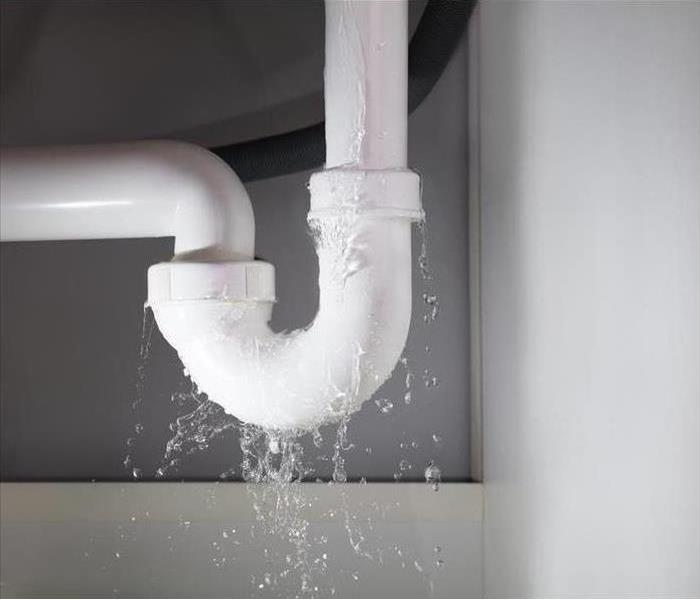 A leaking pipe in a Clearfield, UT, home.
A leaking pipe in a Clearfield, UT, home.
When you are on vacation, the last thing that you want to do is worry about broken water pipe repair. Unfortunately, it does happen when you least expect it. There are some things that you can do to prevent this kind of damage while you are away from Clearfield, UT.
3 Things To Do To Prevent Water Damage While Away
1. Check for Leaks
This may seem obvious, but you should make sure nothing is leaking before you leave. Be sure to check your:
- Toilets
- Pipes
- Sprinklers
- Hoses
- Water heater
A broken pipe can be extremely bad while you are on vacation because it will continue to leak until you come back. If one does break, mold could grow, and you will need a remediation company to clean up the water damage.
2. Insulate, Disconnect and Caulk
Even warmer climates can freeze in the winter. By insulating and caulking around exposed pipes, you can prevent needing a water pipe repair while you are away. You should remove any hoses and cover the spigots of any outdoor water access to prevent these from becoming a problem.
Keep your heat on low when you are not there to prevent indoor pipes from freezing. Remember, when indoor or outdoor plumbing freezes, it can cause a pipe to break, creating leaks at the very least.
3. Turn Off the Water
The best way to avoid coming home to a flooded house is to turn the water off at the main. You can do this by shutting off the main and draining out any excess water. If turning the water off isn't an option, consider having someone watch your house while you are not there. They can turn on the heat in the event of a freeze and notify you if there are any problems.
No one wants to worry about broken water pipe repair while they are on vacation. You can prevent everything from damaged walls to pipes bursting with these simple steps.
The Dangers of Secondary Damage After a Water Event
6/17/2022 (Permalink)
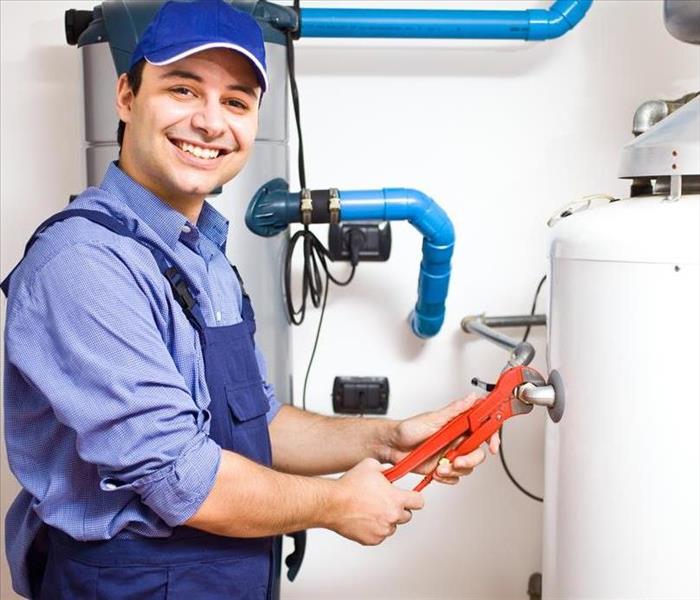 Our Specialists are ready to help After a Water Event. For more information, just contact us.
Our Specialists are ready to help After a Water Event. For more information, just contact us.
If your home in Clearfield, UT, suffers from any type of water damage, it could be susceptible to additional concerns after the initial cleanup. This could occur just a few days later or it could begin to reveal itself a week or two down the road. While black mold is one of the big concerns when water leaks into your home, you also need to be on the watch for lingering smells, deteriorating materials and spoiled carpeting.
The Best Defense Against Secondary Damage
A professional cleanup and restoration from an established water mitigation team is the best way to make sure the recovery process proceeds smoothly. The work will be done by highly-trained technicians who have been certified in the best techniques to clean up a house impacted by heavy storms, flooding or faulty plumbing.
Using standards accepted by the cleaning and restoration industry, the technicians will follow a checklist of proven procedures:
- Respond quickly to the situation
- Develop a sound restoration plan
- Remove standing water from the home
- Reduce areas of high humidity
- Restore and rebuild damaged areas
Lingering moisture can create the perfect conditions for black mold to form and grow on structures throughout your home. A professional team will make sure to treat excess moisture through proper ventilation, drying techniques and the use of fans. Technicians will also take measurements to determine the moisture level in the home, reducing it to about 30 to 60% indoor relative humidity so mold is unlikely to gain a foothold.
The Keys to Eliminating Odors
A poor cleanup job can lead to unpleasant odors after the work crew has left. These will only grow stronger over time, and they also hint at a harmful moisture level. Trained professionals will remove items that are too saturated to restore. This could include drywall, carpeting and insulation. Advanced techniques are used to remove wet insulation and replace it with new materials. Spoiled carpeting and padding will also be torn out and new carpeting will be installed if the damage is too great.
Specially formulated cleaning agents will be used to sanitize the home, killing pathogens and microbes that can grow and cause further damage. This helps deodorize the home. Unless the home is thoroughly cleaned with safe and effective agents, the possibility of returning smells is always possible.
The Answer to Black Mold Growth
Mold enjoys moist conditions and is more likely to trouble your home after any type of water leak or damage. All types of mold are potentially harmful to a home and they are all hard to eradicate as they leave microscopic spores that can colonize a new outbreak. This is especially true if your home still has high humidity levels or if the offending mold spores were not killed by powerful cleaning agents.
While a water leak in your home in Clearfield, UT,, is a challenging event, a professional cleanup and restoration process should take care of most issues. It will also make sure secondary damage in the form of mold growth or unpleasant odors does not cause trouble later on.
Working To Save Your Carpet After a Pipe Break
4/9/2022 (Permalink)
 Follow these Tips and Save Your Carpet After a Pipe Break.
Follow these Tips and Save Your Carpet After a Pipe Break.
If your home in Clearfield, UT, experiences a pipe break, you will have a lot to think about. Among your first concerns will be what in the home is salvageable and what will need to be thrown out. This often means worrying about your carpeting since it is on the floor and is more likely to get wet than anything else. At this time, you will also need to consider the condition of the materials beneath the carpeting, namely the padding.
In a few cases, you will be fortunate and will be able to save your carpeting. If the following conditions exist, your carpet is likely to be clean enough to keep in your home:
- The leaked water is from a clean source
- The leak was discovered quickly
- The carpeting and underlying pad can be dried professionally
- The carpeting is relatively new and in good shape
It is important to understand that each water leak is unique and situational. An experienced water damage repair company is often your best source of information in these circumstances, especially if you wish to keep your expenses to a minimum.
A More Complicated Pipe Break
A Category 1 water leak involves water from a clean source such as drinking water or unused cleaning water. Even with this situation to save many items you have only 24-48 hours to remove the water and dry out items such as clothing and furniture. The most effective water restoration plan is quick and accomplished with industrial vacuums and dryers.
A Category 2 water leak is a bit more serious and usually involves water that is mildly tainted with non-hazardous debris. This is something like the overflow from dishwashers or washing machines. If caught early enough, your carpeting might be salvageable with this leak, but the padding will likely have to be replaced.
A Category 3 leak is anything that involves hazardous materials, black water or water that has been standing for more than two or three days. Some examples of this category of water include the following:
- Overflowing toilets with solid matter
- Floods from exterior sources
- Sewage water
- Stagnant water from any source
Almost anything that comes in touch with the dirtiest water will need to be replaced. Even if an item seems as though it has been cleaned well enough, it still could contain pathogens and other nasty elements, making it safer and healthier to replace.
A Smart Course of Action
If you experience water in your home, it is important to keep safety first and foremost. If you are unsure of the cleanliness of the water, keep children, small pets and anyone else away from the water.
Make sure there are no electrical wires or outlets that could pose a danger to anyone. Watch out for hidden dangers if the water is opaque as it could be hiding obstacles or even small animals such as snakes or rats.
A pipe break in your home is never fun. With the right course of action, you can keep your expenses down and make sure your home remains a healthy place.
Will Filing an Insurance Claim Raise My Rates?
11/16/2021 (Permalink)
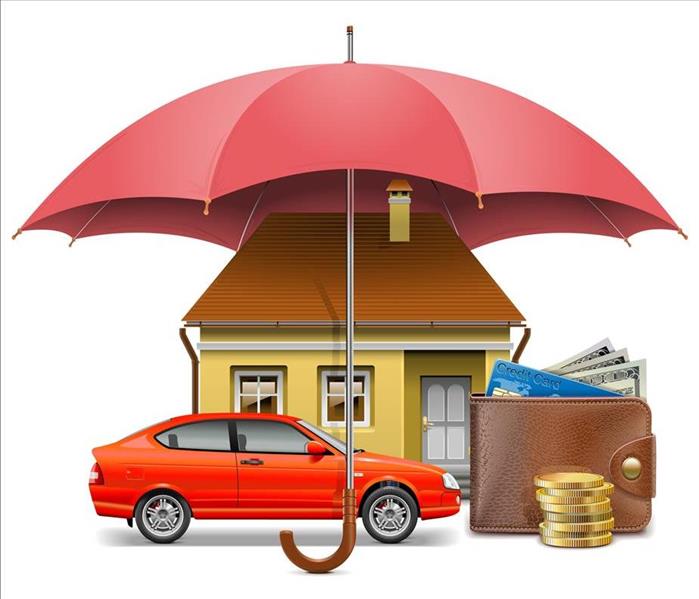 File an insurance claim only when it is essential to avoid increased rates.
File an insurance claim only when it is essential to avoid increased rates.
Homeowners' insurance exists to provide financial protection for homeowners against catastrophic damage to their homes. However, many homeowners fear that filing an insurance claim may cause their rates to go up. This isn't always the case.
How an Insurance Claim Affects Your Rates
Insurance premiums are primarily based on risk. For homeowners insurance, insurance companies consider both the risks associated with the policyholder and the property being insured. Several factors can affect insurance rates:
- Value of your home
- Your credit history
- Age of your home
- Location of your home
- Materials your home is constructed from
- Your claims history
- Your marital status
Homes that are worth more money and cost more to replace usually cost more to insure. Insurance companies also consider location-based risk factors, such as weather conditions and proximity to water sources. Homes that are made out of materials that better withstand fires, wind and other perils may cost less to insure. Finally, the fewer claims you have filed and the less those claims cost your insurance company, the less you are likely to pay.
Why Claims History Matters
Past behavior often predicts future behavior. Policyholders who have filed claims in the past are more likely to file claims in the future. However, the type of claim, how long ago the claim was filed and the cause of the damage also has an impact on whether filing a new claim will increase your rates.
Claims That Are Likely To Increase Your Rates
Insurance companies consider some types of claims to be a greater indicator of a high risk of additional claims than others. Dog bites, water damage, personal injury claims, and mold claims fall into this category.
Claims That Are Less Likely To Cause a Rate Increase
Small homeowners' claims, such as minor water damage caused by a pipe burst, may not result in rate increases unless you make a lot of them. If the insurance company determines that you are filing a lot of small claims because you are not properly maintaining your home, they may increase your rates or refuse to renew your policy.
Typical Rate Increases
A typical claim may result in a rate increase of 20% to 40%. Your rates may remain higher for several years and then go back down if you do not file additional claims. Some insurance companies may not raise rates for a first claim or claims under a certain dollar amount.
When To File a Claim
If you have a home flood or other major disaster, you may have no other choice than to file a claim. It probably does not make financial sense to pay for large amounts of damage out of pocket when you have insurance. For smaller claims, such as the cost to hire a remediation company in Clearfield, UT, to clean up a minor mold problem, you should weigh the cost of paying for the damage out of pocket versus the potential increase in your insurance rates.
Purchasing insurance won't do you much good if you are afraid to ever file an insurance claim. However, making wise decisions about which claims to file can help keep premiums low.
Dealing With Toilet Overflow
11/12/2021 (Permalink)
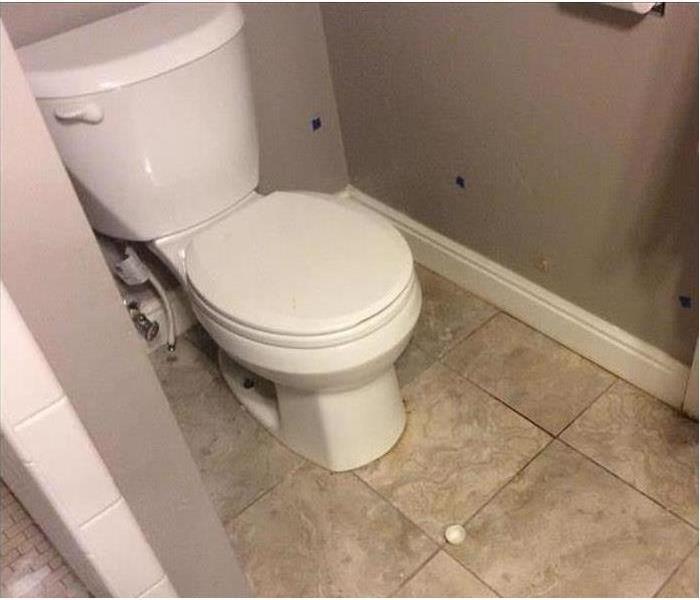 Avoid toilet floods in your Clearfield, UT home.
Avoid toilet floods in your Clearfield, UT home.
When a toilet floods your home in Clearfield, UT, it is unlikely that you are dealing with clean water that can just be sopped up with a towel. To properly mitigate sewer damage, you will need to take certain precautions and enlist the help of certified sewer cleanup experts.
5 Steps for Dealing With Toilet Overflow
- Protection
Safety is the first thing you should consider. Because the water from a flooded toilet is a Category 3 contaminant, it is imperative that you keep pets and children away from the area. Do not enter it yourself unless you are wearing protective gear, such as coveralls, goggles, a face mask, and rubber boots.
- Air Flow
Fresh air can displace the microbes that are in the affected area’s airspace. If possible, open a window to increase ventilation. Avoid using your HVAC system to do so, however, as this simply allows the airborne germs resulting from sewer damage to spread to other parts of your home.
- Sewage Removal
The team from the sewage company will remove the water from the area. All items such as rugs or linens that the water touched must be removed as well.
- Drying
After the standing water is removed, all surfaces must be dried. If the contaminated water has seeped into the floors or wall, it will likely need to be replaced with dry, undamaged materials.
- Disinfection
The final step is making sure everything is clean. Mitigation professionals use special detergents and other methods to clean the remaining surfaces in the room as well as any items that can be salvaged. No item can return to your home unless it can be restored properly.
Sewer damage requires swift attention and remediation. Start with the appropriate safety measures and make sure all the appropriate steps of the cleanup process are taken. With a prompt call to certified experts, you can get your bathroom restored relatively quickly.
How To Perform Pipe Burst Cleanup
10/6/2021 (Permalink)
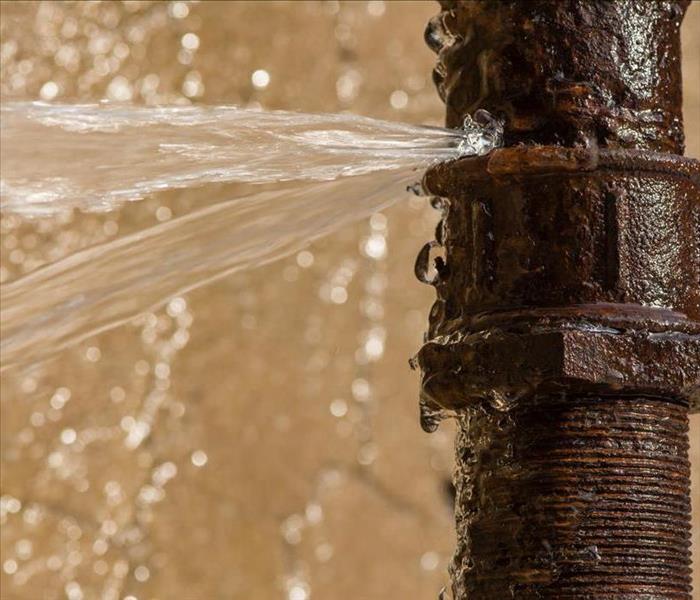 When a pipe bursts, clean the water to avoid further damage in your Clearfield, UT building.
When a pipe bursts, clean the water to avoid further damage in your Clearfield, UT building.
Freezing weather or aging or damaged pipes can cause a pipe to burst, creating a messy situation that requires pipe burst cleanup to avoid additional damage. This guide will walk you through some steps you can take when you are dealing with a burst pipe.
7 Step Water Cleanup Process
Whatever the cause of your burst pipe, it is important to perform water cleanup within 24 to 48 hours. After that point, even clean water can become hazardous to come in contact with and mold growth may because an issue. These seven steps can help you get your property cleaned up and dried out.
1. Shut Off the Water
Whether you have a broken pipe or a supply line leaking, the first step is to mitigate the damage by turning off the water supply. Make note of the location of the main water shut-off valve at your facility so that you can access it quickly when a problem occurs.
2. Remove Wet Contents
The longer anything that is wet stays in your building, the more likely you are to have problems with mold. Move wet furniture and other contents out of the building. Items that can be salvaged can be left in the sun to dry out. Other items, such as wet carpet or drywall, should be thrown out.
3. Remove Standing Water
A submersible pump is the most effective tool to use for removing water. If you don't have one, you may be able to rent one. Alternatively, you can contact a water remediation company in Clearfield, UT, to handle the job for you. For smaller amounts of water, you may be able to remove it using a wet-dry vacuum, a bucket, or a mop.
4. Dry Out Your Property
Once the water is gone, the next most important part of pipe burst cleanup is to dry out your property. Fans and dehumidifiers are useful tools for this process. If the weather permits it, open windows and doors to get some air circulating.
5. Tear Out Damaged Materials
Some materials are difficult to salvage once they get wet. You may need to remove and replace carpeting, carpet pads, flooring, drywall, cabinets, hardwoods, and ceilings.
6. Fix the Broken Pipe
Before you can turn the water back on, you need to cut out the section of the broken pipe and replace it. You can tackle this job at any point in the restoration process, but it is usually easier after you have removed damaged materials, but before you have started replacing them.
7. Clean and Disinfect Surfaces
Water from a burst pipe is usually clean water, but it is still a good idea to clean and disinfect surfaces that were in contact with the water. Use a mild detergent to clean surfaces and then apply a disinfectant, such as diluted bleach. Opening windows can help remove odors. If odors linger, you may want to use an ozone machine.
Once you have completed the pipe burst cleanup process, you can begin repairing your damaged property. Regularly inspecting your plumbing may help you avoid a recurrence of the problem.
Tips for Handling Water Damage
9/14/2021 (Permalink)
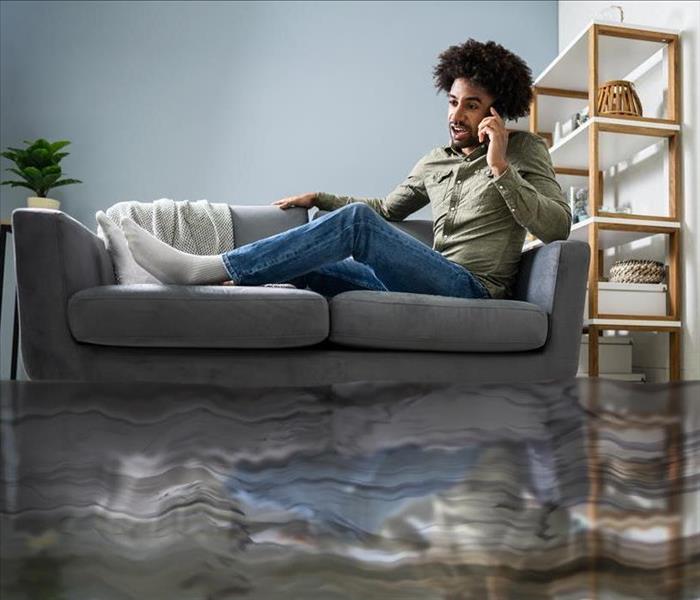 Knowing how to handle a leak will minimize the water damage in your Clearfield, UT home.
Knowing how to handle a leak will minimize the water damage in your Clearfield, UT home.
A broken pipe can cause a huge water loss in a short amount of time. What you do right after it happens can determine how much damage it ends up causing.
How to minimize leak damage
Don't Ignore Signs of Water Damage
One of the problems with a pipe break or any water loss that happens behind a wall or inside a cabinet is that you may not discover it until damage has already been done. Watch for common signs that you have a leak:
- Dark spots on walls or ceilings
- Bulging drywall
- Swollen floorboards
- Excessive humidity levels
- Unusual spraying or dripping sounds
Do Turn off Water
If you see a spot on the wall suddenly darken and spread, or you hear something inside the wall that spells trouble, the best thing you can do is turn off the water main. While inconvenient, temporarily turning off the flow for the whole house minimizes the amount of water in your home in Clearfield, UT. Once a plumber has repaired the pipe, the water can be turned back on.
Don't Wade Through Standing Water
A large water loss will often result in standing water. Fight the urge to wade into it to retrieve items, particularly if you cannot see below the surface or you don't have the proper personal protective equipment to do so. Sharp objects or tripping hazards may be present. More importantly, if the water has come into contact with electrical items, it may also be charged.
Do Contain the Flow
When a broken pipe floods your home enough to cause pooling, there are still steps you can take to keep it from spreading. Try to seal off the area as well as possible by using barriers such as rolled towels, sandbags, or tarps. You may not be able to prevent damage to the main flood area but you can block the path of the water into other spaces.
Don't Clean Contaminated Areas Yourself
A backed-up sewer or flooding from a storm can leave a big, smelly mess behind. When this happens, it can be tempting to grab the disinfectant and clean everything immediately. Unless you know the full extent of the damage, though, this may make the problem worse and affect the preliminary tests on the area when the mitigation team arrives.
Do Call Professionals Immediately
The best thing you can do when you have a flooded home is to call flood damage remediation experts as soon as you are aware of the problem. Within hours, they can come to your home, inspect it and give you an overview of what the cleanup process entails. They have the equipment and the expertise it takes to address the issues caused by the water loss and to prevent further damage.
Fast mitigation is the key to dealing with damage left by a broken pipe. The sooner you call certified professionals to repair the damage and restore the structure, the better. Start the cleanup process quickly, and your home can get back to normal in no time.
What Is Category 1 Water Damage?
8/11/2021 (Permalink)
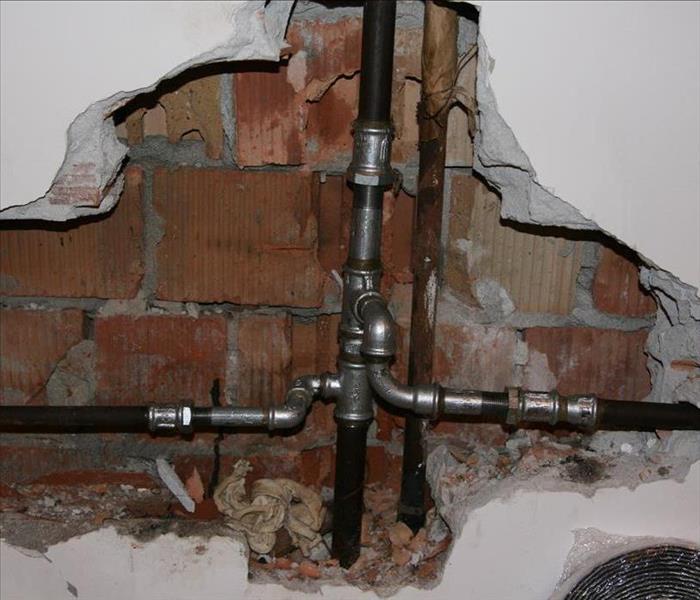 Category 1 water damage in a Clearfield, UT, building.
Category 1 water damage in a Clearfield, UT, building.
When you have water damage in your building, it is important to clean it up and dry your property out as quickly as possible to avoid additional damage. The type of restoration that needs to be done can vary depending on whether the damage is from clean water, grey water, or black water. Different types of water damage are classified according to category.
What Category 1 Water Damage Is
Category 1 water damage is usually the easiest type of water damage to deal with because it is water from a clean source. There are multiple examples of sources of category 1 damage:
- Broken pipe
- Broken supply line
- Overflow from a clean sink or tub
- Some appliance leaks
The distinguishing feature of this type of water damage is that it doesn't contain harmful bacteria or chemicals that require protective gear when cleaning it up.
What To Do When You Have Category 1 Water Damage
The first thing to do is shut off the source of the clean water. If the water is coming from a broken pipe, shut off the water to your house. If it is an overflowing sink or tub, turning off the tap should work. If you have an appliance that is leaking, unplug it, shut off the water and disconnect the supply line. You may need to place towels around the base to soak up any water that is still coming out.
Once you have shut off the source of the water, clean up the water damage as soon as possible. You can use a mop and bucket, sponges, or a wet/dry vacuum. Wet carpeting can be difficult to fully dry and may need to be replaced. If there is a lot of water damage, you may want to contact a water restoration company in Clearfield, UT. Some types of water damage may be covered by your insurance company. Contact your insurance professional to find out if you should file a claim.
Why It is Important To Dry Your Property Quickly
Mold and mildew thrive in wet conditions and can begin growing in 24 to 48 hours after water damage. The faster you can dry out your property, the less likely you are to experience mold growth. This may also help you avoid other problems, such as warping and rot. Additionally, standing water that sits for too long can become contaminated and may require professional cleaning services to be safely removed.
How You Can Avoid Future Problems
Avoid overflows by not letting sinks and tubs run while unsupervised. Have your appliances regularly maintained. Check for signs of a water leak, such as musty odors, unusual sounds, water pressure issues, stains, discolored water, or unexplained increases in your water bill. Fix or replace leaking pipes promptly. Insulate your pipes in cold weather to avoid potential damage caused by freezing temperatures. Drain your pipes if your building will not be in use for extended periods.
Water damage from clean water is the easiest type of water damage to deal with. However, it still requires prompt attention to avoid unnecessary additional damage to your property.
Why You Should Only Trust IICRC Certified Technicians
6/28/2021 (Permalink)
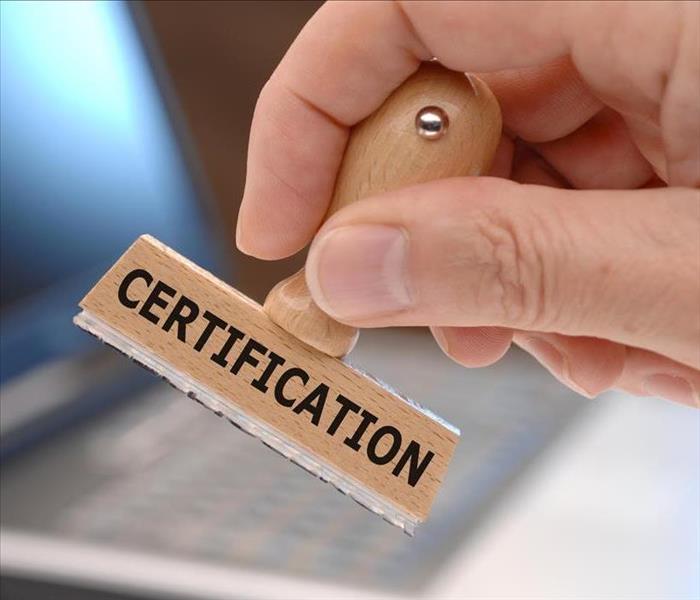 A certified and expert work team provides the best experience and the assurance that your home is in the hands of professionals.
A certified and expert work team provides the best experience and the assurance that your home is in the hands of professionals.
You shouldn’t let just anybody into your home to clean up after a water disaster. The Institute of Inspection, Cleaning and Restoration Certification (IICRC) is a recognized certification for the cleaning and restoration industry. The non-profit presents the gold standard in mitigation and cleaning techniques. If you want a technician who promises the best disaster recovery possible, find a business that is IICRC certified in Clearfield, Utah, because these businesses promise a few things above other non-licensed or certified companies.
1. A Correctly Trained Crew
A company with a mitigation certificate is more than a brand with a logo; it is a business with highly skilled employees. Certification is only obtained by those businesses that ensure the training and continued education of their technicians. The training includes:
- Fire restoration
- Water restoration
- Mold mitigation
- Carpet and upholstery cleaning
- Crew training
- Applied structural drying
- Restorative drying for loss control
2. Professional Connections and Management
Certified franchises and technicians only work with the best. The company will have a list of other approved technicians and services they work with, allowing customers to feel comfortable in the project. Additionally, franchises, such as SERVPRO, work with national account managers, helping homeowners, technicians, and insurance companies coordinate throughout the project.
3. Peace of Mind
Aside from dealing with a trained crew, working with certified and licensed experts provides peace of mind. You know the work being done on your home is guaranteed. If a problem arises related to the original issue after the cleanup and restoration, the company will stand by their work, ensuring you worry-free nights.
An IICRC certificate is more than a piece of paper or symbol on a business card. It is a promise that the professionals with the credentials understand the cleaning, mitigation, and restoration process. Your home is not a place to allow just any repair technicians; only the best should be given the privilege to work where you sleep.




 24/7 Emergency Service
24/7 Emergency Service








